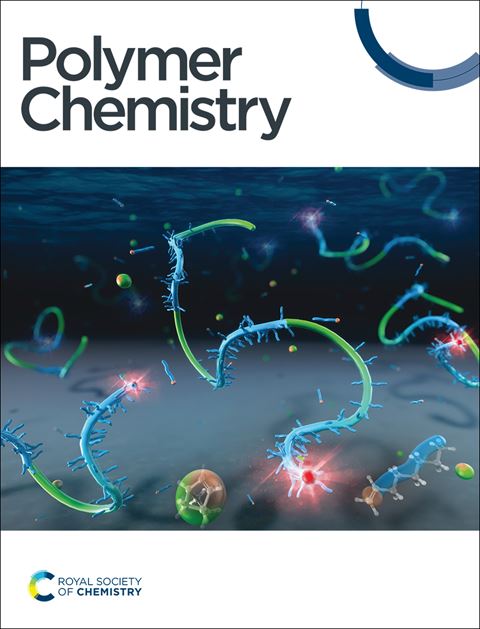通过简单甲基化工程调制(双噻吩)苯连接聚合物受体的包装和光伏性能
IF 4.1
2区 化学
Q2 POLYMER SCIENCE
引用次数: 0
摘要
采用含不同甲基取代苯基的(双噻吩)苯连接剂,设计合成了三种聚合小分子受体(psma),分别为PY-TP、PY-TPMe2和PY-TPMe4。所有psma在薄膜和LUMO能级中表现出相似的吸收最大值。然而,连接体上甲基数量的增加会引起位阻,降低聚合物骨架的共平面度,从而增加分子间π-π堆积距离。当三种受体与经典聚合物给体PM6共混时,具有高扭曲骨架的PY-TPMe4具有较大的π-π堆积距离和过多的相分离,而具有中等扭曲骨架的PY-TP和PY-TPMe2具有更紧密的π-π堆积和合适的相分离形态。因此,PY-TP和PY-TPMe2表现出更好的激子解离和电荷输运,从而导致比PY-TPMe4更高的光伏性能。特别是PY-TPMe2有效地调节了结晶度,在共混膜中实现了更合适的相分离形态。最优的py - tpme2光电器件具有最佳的激子解离和电荷输运性能,其功率转换效率(PCE)为8.4%,开路电压(VOC)为0.97 V,短路电流密度(JSC)为14.74 mA cm⁻²,填充系数(FF)为59.65%。这些发现为通过对连接体进行简单甲基化修饰来调控聚合物受体的分子包装和光伏性能提供了新的见解,可用于设计新型psma材料。本文章由计算机程序翻译,如有差异,请以英文原文为准。

Modulating the packing and photovoltaic performance of (bisthiophene)benzene-linked polymer acceptors through simple methylation engineering†
Three polymerized small molecule acceptors (PSMAs), namely PY-TP, PY-TPMe2, and PY-TPMe4, were designed and synthesized by employing (bisthiophene)benzene linkers containing various methyl-substituted phenylene groups. All the PSMAs exhibit similar absorption maxima in films as well as LUMO energy levels. However, the increased number of methyl groups on the linkers induces steric hindrance and decreases the coplanarity of the polymer backbones, which, in turn, increases intermolecular π–π stacking distances. When the three acceptors are blended with a classical polymer donor PM6, PY-TPMe4 with a highly twisted backbone has a large π–π stacking distance and excessive phase separation, whereas PY-TP and PY-TPMe2 with moderately twisted backbones demonstrate more compact π–π stacking and suitable phase separation morphology. As a result, PY-TP and PY-TPMe2 exhibit better exciton dissociation and charge transport, leading to much higher photovoltaic performance compared to PY-TPMe4. Particularly, PY-TPMe2 effectively regulates the crystallinity and achieves a more suitable phase separation morphology in the blend films. The optimal PY-TPMe2-based photovoltaic device exhibits the best exciton dissociation and charge transport performance, achieving the highest power conversion efficiency (PCE) of 8.4% among the devices based on the three PSMAs, with a high open-circuit voltage (VOC) of 0.97 V, a short-circuit current density (JSC) of 14.74 mA cm−2 and a fill factor (FF) of 59.65%. These findings provide new insights into the regulation of the molecular packing and photovoltaic performance of polymer acceptors through simple methylation modification on linkers for designing novel PSMA materials.
求助全文
通过发布文献求助,成功后即可免费获取论文全文。
去求助
来源期刊

Polymer Chemistry
POLYMER SCIENCE-
CiteScore
8.60
自引率
8.70%
发文量
535
审稿时长
1.7 months
期刊介绍:
Polymer Chemistry welcomes submissions in all areas of polymer science that have a strong focus on macromolecular chemistry. Manuscripts may cover a broad range of fields, yet no direct application focus is required.
 求助内容:
求助内容: 应助结果提醒方式:
应助结果提醒方式:


